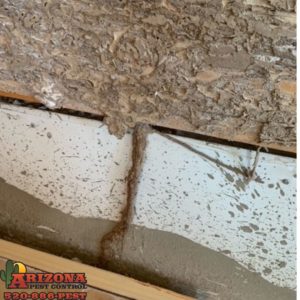Unlike subterranean termites that dwell mostly in the soil beneath the ground, drywood termite colonies are completely contained within above ground wood sources. While subterranean colonies are largely made up of workers that tunnel through soil in search of fibrous plant material to feed on, drywood termite colonies do not produce workers that forage away from the nest, as they literally live within their food source. Reproductive swarmers (alates) are the only termites that leave drywood colonies, and they do so during their annual mating swarms in order to establish new colonies elsewhere.
Drywood termite colonies include a queen and king (the royal pair), soldiers, immatures, and once a colony has aged a few years, reproductive alates are produced. While subterranean termite workers gather food for their nest mates, drywood termite colonies contain what are called “immatures” that are responsible for gathering food for their nestmates. However, as mentioned above, immatures do not leave their colony in order to gather food; instead, immatures use their specialized mandibles to excavate bits of wood from their nesting site before feeding the bites to their nestmates. Drywood termite colonies are usually located in logs, fallen branches, and timber components within houses, as well as on the exterior walls and roofs of houses.
Since drywood termites are confined to a single wood item, their colonies contain far fewer termites that subterranean termite colonies. To illustrate, mature drywood termite colonies contain a few thousand individual termites, while mature subterranean termite colonies contain between 50,000 to over 1 million, depending on the species. As more termites are added to a drywood termite colony, more immatures are tasked with excavating wood from their nest, which consequently, expands their living space within wood items. Naturally, drywood termite colonies mature at a much slower rate than subterranean termite colonies, which is why drywood termite damage to structural wood is usually not as extensive as the damage inflicted by subterranean termites. However, while subterranean termite workers always infest homes from the ground up and leave behind conspicuous mud tubes, a pair of airborne drywood alates are able to initiate a nest anywhere on or within a home where they leave no indication of their presence. Therefore, while subterranean termites are the most destructive group of termites, drywood termites are the most difficult to detect.
Have you ever suspected your home of being infested with drywood termites?












